Planning a trip to Morocco can be exciting, yet overwhelming. But don’t worry, SIXT.VN offers comprehensive travel solutions to make your Moroccan adventure seamless and unforgettable. This guide provides essential information and tips, ensuring you’re well-prepared to explore the vibrant culture, stunning landscapes, and hidden gems of Morocco. With SIXT.VN, you can easily navigate Morocco with confidence, whether you’re seeking airport transfers, hotel bookings, or expertly guided tours.
1. Do I Need A Visa To Visit Morocco?
No, citizens from the USA, Canada, the UK, EU countries, Australia, New Zealand, and many other countries do not need a visa for stays shorter than 90 days in Morocco. As of now, there are no COVID-19 related travel restrictions.
- Visa Exemption: Check the latest visa requirements based on your nationality to ensure a smooth entry.
- Stay Duration: Ensure your visit does not exceed the 90-day limit to avoid any legal complications.
2. Where Is Morocco Located?
Morocco is located in Northwest Africa, just south of Spain, across the Strait of Gibraltar. Its location gives it a blend of African, European, Arab, and Berber cultures.
- Strategic Location: Morocco’s position makes it easily accessible from both Europe and other parts of Africa.
- Cultural Crossroads: This unique location contributes to Morocco’s diverse cultural heritage.
3. How Can I Travel To Morocco?
The most common way to travel to Morocco is by air. The major airports are Casablanca Airport (CMN) and Marrakech Menara Airport (RAK). Many major airlines, including Delta, American Airlines, Emirates, British Airways, and Air Canada, serve these airports. You can also reach Morocco by ferry from Spain.
- Flights:
- Casablanca Airport (CMN): Serviced by major airlines, including United Airlines.
- Marrakech Menara Airport (RAK): Serviced by many major airlines, but not United Airlines.
- Flexible Itinerary: Consider flying into one airport and out of another to optimize your travel plan.
- Ferries:
- From Spain: Ferries from Algeciras and Tarifa to Tangier are the fastest routes, taking 60-90 minutes.
- Longer Routes: Barcelona to Tangier can take 28 to 36 hours.
- Car Ferries: You can also take your car by ferry, requiring extra planning.
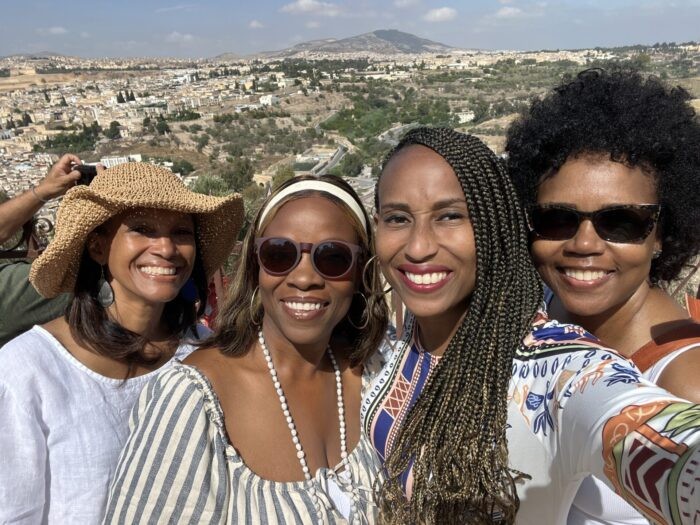 Fes city views, showcasing Morocco's rich architectural heritage and vibrant urban landscape
Fes city views, showcasing Morocco's rich architectural heritage and vibrant urban landscape
4. How Can I Get Around In Morocco?
Getting around Morocco is relatively easy with several transportation options available.
4.1. Trains
Morocco’s rail network is comfortable and generally punctual, connecting major northern cities at affordable rates.
- Comfort and Reliability: Trains are a good option for traveling between major cities.
- Affordable: Rail travel is reasonably priced, making it a budget-friendly choice.
4.2. Buses
Public and private bus companies connect cities throughout the country. However, buses can be slow and overcrowded.
- Extensive Network: Buses reach almost every part of Morocco.
- Consider Alternatives: For shorter trips, taxis may be a better option.
4.3. Taxis
There are two types of taxis in Morocco: petit taxis and grand taxis.
- Petit Taxis: These smaller vehicles carry up to three passengers and are ideal for getting around cities.
- Grand Taxis: Larger vehicles carry up to six passengers, mainly used for traveling between cities.
- Ride-Sharing Apps: Uber is not available, but “Careem” operates in some major cities. In Marrakech, try “Heetch” and “Roby.”
- Concierge Services: Hotels and Riads can arrange car and driver services for you.
4.4. Planes
For long distances between major cities, consider domestic flights with Royal Air Maroc and Air Arabia Maroc.
- Time-Saving: Domestic flights can save significant travel time.
- Airline Options: Choose between Royal Air Maroc and Air Arabia Maroc for domestic travel.
5. When Is The Best Time To Visit Morocco?
The best time to visit Morocco is during the spring (March to May) and fall (September to November). The weather is pleasant, and it’s outside the peak tourist season.
- Spring and Fall: Ideal for comfortable temperatures and fewer crowds.
- Avoid Summer Heat: Cities like Marrakech can become uncomfortably hot in the summer.
- Consider Ramadan: Be aware of potential closures during Ramadan.
5.1. Planning Around Religious Holidays
Islam is Morocco’s official religion. Ramadan, lasting 30 days in March/April or April/May, is an important consideration.
- Ramadan Impact: Most local restaurants and cafes are closed during the day.
- Evening Celebrations: If you visit during Ramadan, enjoy the vibrant post-sunset celebrations.
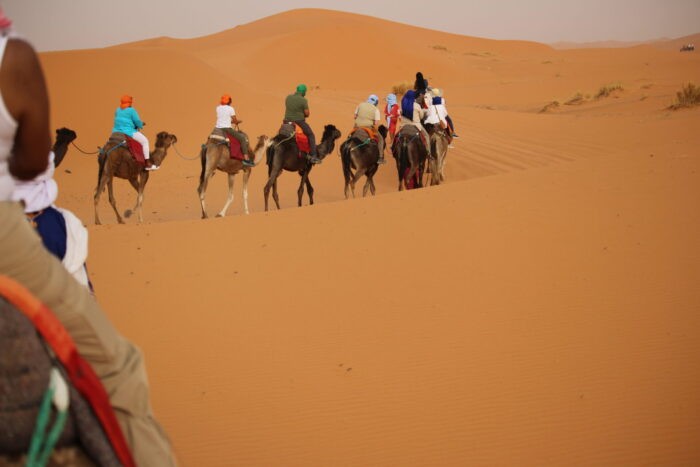 Sunset camel ride in the Sahara, capturing the enchanting beauty and vastness of Morocco's desert landscape
Sunset camel ride in the Sahara, capturing the enchanting beauty and vastness of Morocco's desert landscape
5.2. Seasons & Weather In Morocco
- Northern Cities (Casablanca, Tangier): Mediterranean climate with average summer temperatures of 73 °F (23 °C) and winter temperatures of 55 °F (13 °C).
- Central and Southern Cities (Fes, Marrakech): Hot summers (average in the 90s, can hit triple digits) and mild winters (average 54 °F or 12 °C).
- Rainy Season: Most rain falls from November to March, especially in coastal regions.
6. What Languages Are Spoken In Morocco?
Morocco has two official languages: Modern Standard Arabic and Standard Moroccan Berber. Moroccan Arabic and various dialects of Moroccan Berber are most commonly spoken. French is also widely used due to Morocco’s history as a French protectorate.
- Official Languages: Arabic and Berber.
- Commonly Spoken: Moroccan Arabic and Berber dialects.
- French Usage: French is widely spoken, particularly in business and government.
6.1. Do They Speak English In Morocco?
English is not widely spoken, but most people in the tourism industry have basic English skills.
- Tourism Industry: English is common in hotels, restaurants, and tourist sites.
- Learn Basic Phrases: Knowing a few Arabic or French phrases can enhance your experience.
7. What Is The Currency Used In Morocco?
The currency in Morocco is the Moroccan Dirham (MAD). Many establishments only accept cash, so use ATMs to withdraw local currency.
- Cash Preference: Carry cash for small shops, tips, and souks.
- ATM Availability: ATMs offer decent exchange rates.
- Credit Cards: Most restaurants and main shops accept credit cards, but not usually American Express.
8. What Is The Appropriate Way To Dress In Morocco?
Most women in Morocco dress modestly, following Muslim customs. It’s advisable to dress modestly: cover your chest, shoulders, and knees.
- Modest Clothing: Lightweight pants, long dresses, and skirts (below the knee) are suitable.
- Mosque Visits: Cover your shoulders and chest when visiting mosques. Head coverings are not always required, but bring a scarf just in case.
- Marrakech: Dress is generally more casual in Marrakech.
- Shoe Removal: Remove shoes when entering mosques and carry a bag for them.
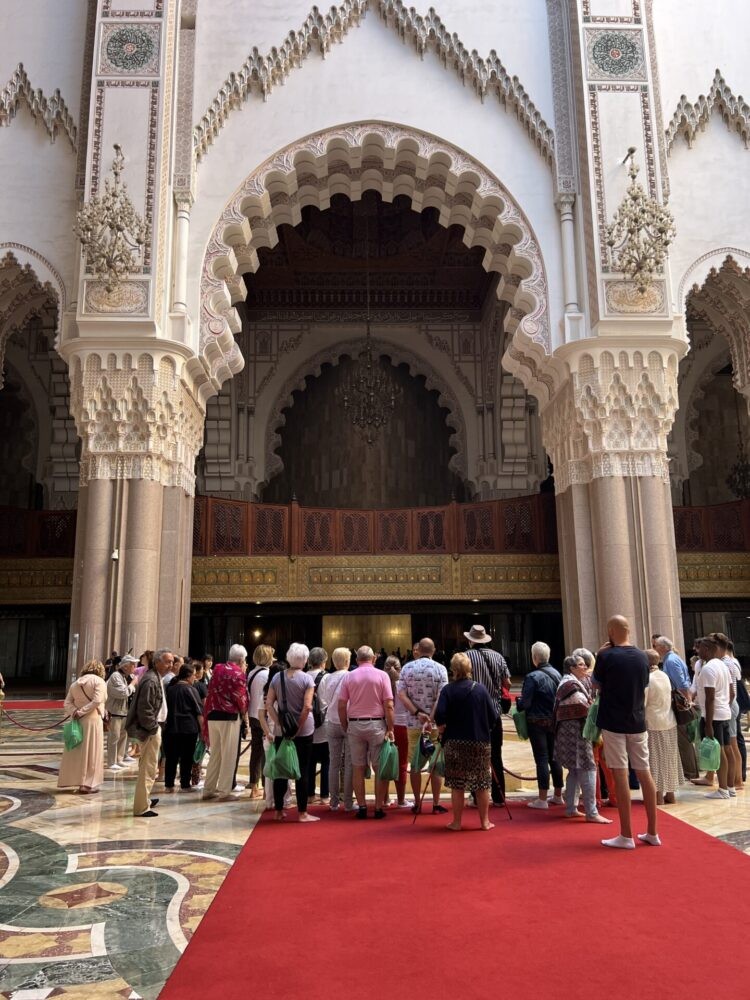 Woman at Hassan II Mosque, Casablanca, showcasing the mosque's stunning architecture and the tradition of removing shoes before entry
Woman at Hassan II Mosque, Casablanca, showcasing the mosque's stunning architecture and the tradition of removing shoes before entry
9. Where Should I Stay In Morocco?
Riads are popular places to stay in Moroccan cities. These are traditional houses or palaces with interior gardens or courtyards, often located in the Medinas.
- Riads: Hotels or guesthouses with shared common areas and gardens.
- Medina Location: Convenient for dining and shopping.
- Quiet Alternatives: Hotels and resorts outside the Medina offer a quieter experience.
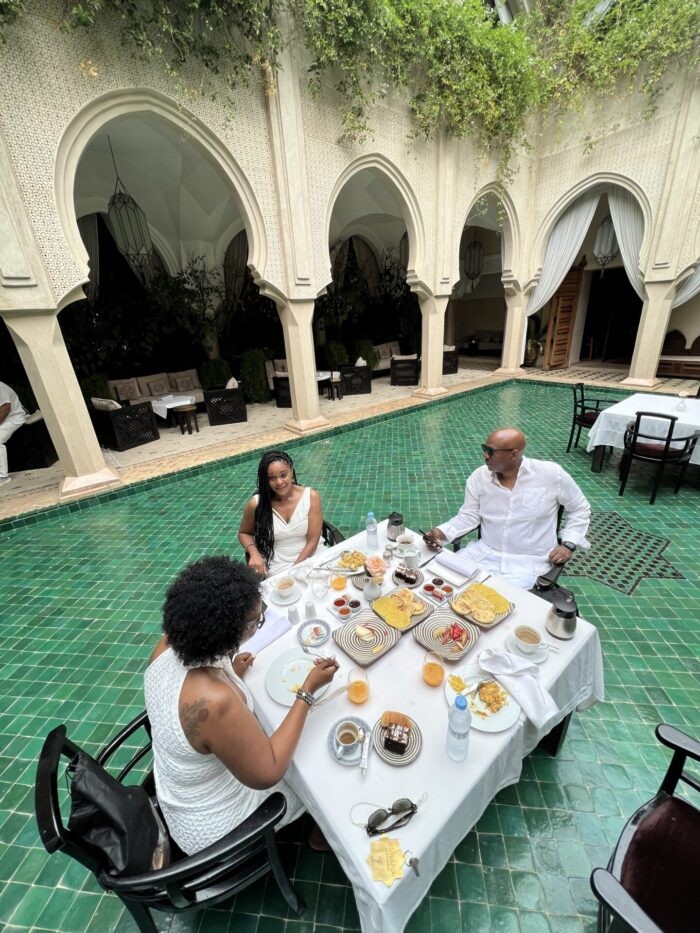 Interior of Riad Almaha, Marrakech, highlighting the traditional Moroccan architecture and serene ambiance of a Riad stay
Interior of Riad Almaha, Marrakech, highlighting the traditional Moroccan architecture and serene ambiance of a Riad stay
10. What Are The Best Places To Visit And Things To Do In Morocco?
Morocco offers a diverse range of attractions, from bustling cities to tranquil deserts.
10.1. Casablanca
A modern city with historic touches.
- Hassan II Mosque: One of the largest mosques in the world, open to non-Muslims.
- Mohamed V Square: A bustling hub for locals.
- The Museum of Moroccan Judaism: Showcases the 2,000-year history of the Jewish community in Morocco.
10.2. Fes
An ancient and historic city with narrow streets and majestic mosques.
- Royal Palace: Admire the stunning seven front gates.
- Jewish Cemetery: An expansive cemetery established in 1883.
- Madrasa Bou Inania: A 14th-century Muslim learning institute with beautiful architecture.
- Borj Nord: A 16th-century fort housing the Museum of Arms.
- Medina: One of the most expansive historic districts with residences, shops, and markets. Be cautious and keep belongings close.
- Chouara Tanneries: Witness animal skins and hides being dyed. Be prepared for a strong smell and the option to haggle when shopping for leather goods.
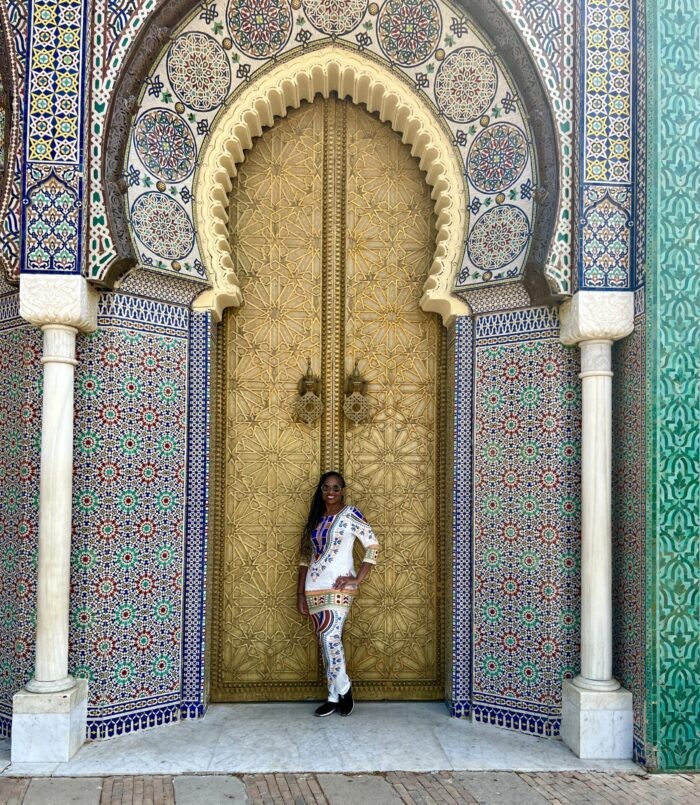 Fes Palace doors, showcasing the intricate craftsmanship and architectural grandeur of Moroccan palaces
Fes Palace doors, showcasing the intricate craftsmanship and architectural grandeur of Moroccan palaces
 The bustling Medina of Fes, capturing the vibrant atmosphere and intricate alleyways of Morocco's historic markets
The bustling Medina of Fes, capturing the vibrant atmosphere and intricate alleyways of Morocco's historic markets
10.3. Merzouga
A tranquil town in the Sahara Desert, acting as a gateway to Erg Chebbi.
- Merzouga Desert: Go glamping, ride camels, and witness the starlit sky. Sandboarding is also available.
- Erg Chebbi Dune: Hike to the highest dune, bringing water and avoiding midday heat.
- Dayet Srji: A salt lake west of Merzouga, attracting migratory birds like flamingos.
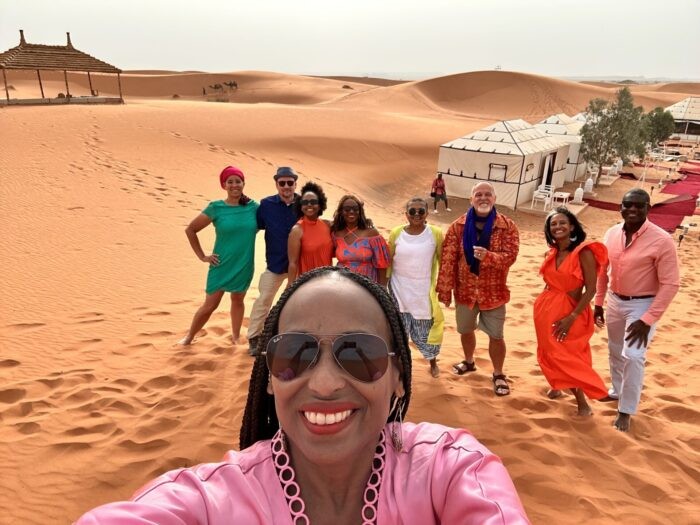 Group photo at a glamping site in Merzouga, capturing the colorful attire and joyful experience of desert glamping
Group photo at a glamping site in Merzouga, capturing the colorful attire and joyful experience of desert glamping
10.4. Dades Valley/Dades Gorge
A scenic valley nestled in the Atlas Mountains.
- Boumalne Dades: The main city on a plateau surrounded by cliffs.
- Auberge Chez Pierre Hotel: A lovely hotel offering modern comforts and a 5-course meal for 22 euros.
- Dades Valley: Explore towering cliffs and fertile gardens.
- Rose Valley and Kelaat M’Gouna: Immerse yourself in Morocco’s Berber culture.
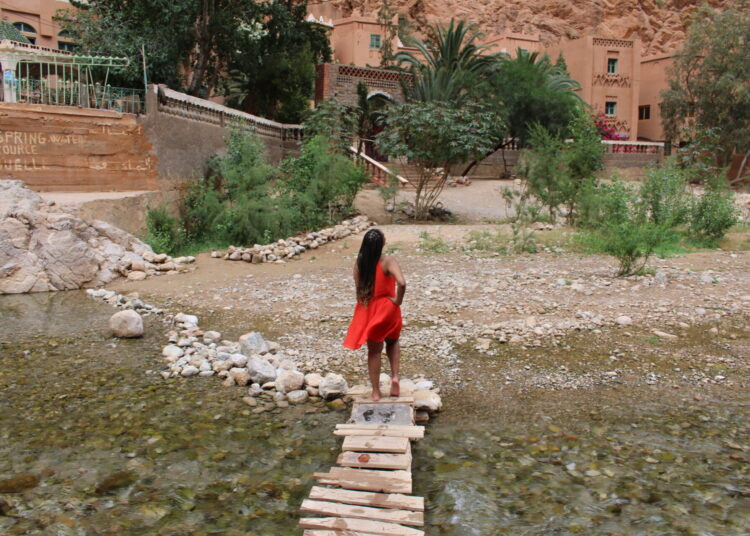 Nadeen exploring Dades Gorge, showcasing the stunning rock formations and scenic beauty of the Moroccan landscape
Nadeen exploring Dades Gorge, showcasing the stunning rock formations and scenic beauty of the Moroccan landscape
10.5. Marrakech
A city blending tradition and modernity.
- Koutoubia Mosque: The largest mosque in Marrakech, also known as “Mosque of the Booksellers.”
- Jemaa el-Fnaa: A bustling square with street performers, musicians, and food stalls.
- Bahia Palace: An opulent palace with tranquil courtyards and lush gardens.
- Jardin Majorelle: A lush botanical garden and former residence of Yves Saint Laurent, featuring the iconic “Majorelle Blue.”
- YSL Museum: Exhibits of Yves Saint Laurent’s work, including garments, accessories, and sketches.
- Hotel La Maison Arabe: Offers Tagine cooking classes and Hammam spa treatments.
- Jnane Tamsna: A Black, woman-owned hotel about 15 minutes from the Medina.
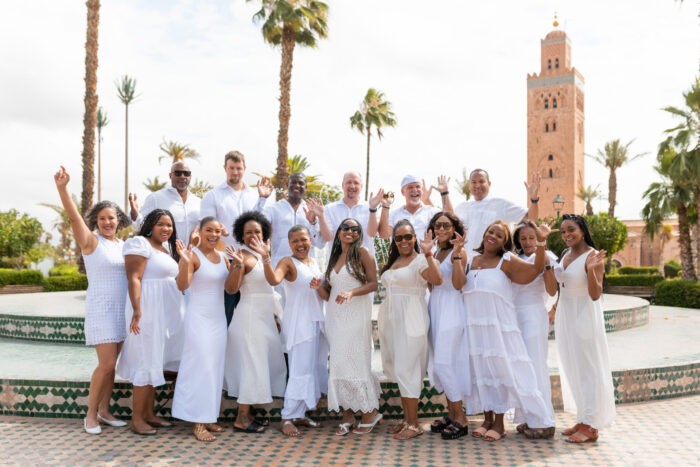 Group picture with the Kutubiyaa minaret in Marrakech, highlighting the iconic landmark and vibrant city atmosphere
Group picture with the Kutubiyaa minaret in Marrakech, highlighting the iconic landmark and vibrant city atmosphere
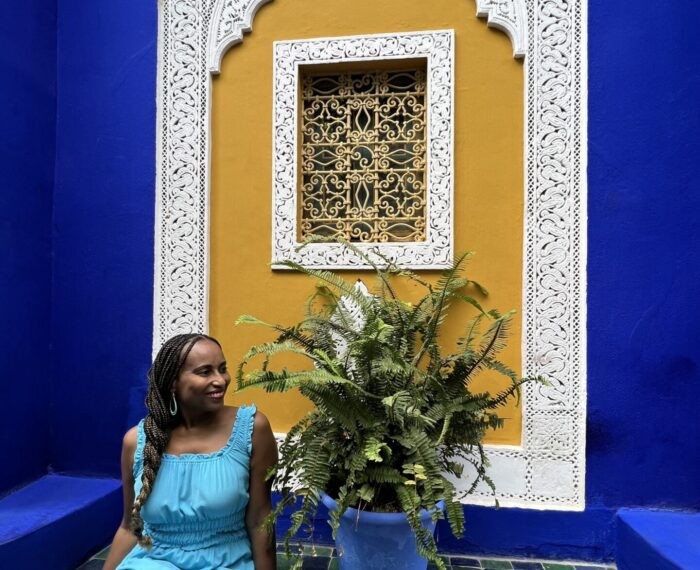 Nadeen at Majorelle Jardin, Marrakech, capturing the vibrant colors and botanical beauty of the famous garden
Nadeen at Majorelle Jardin, Marrakech, capturing the vibrant colors and botanical beauty of the famous garden
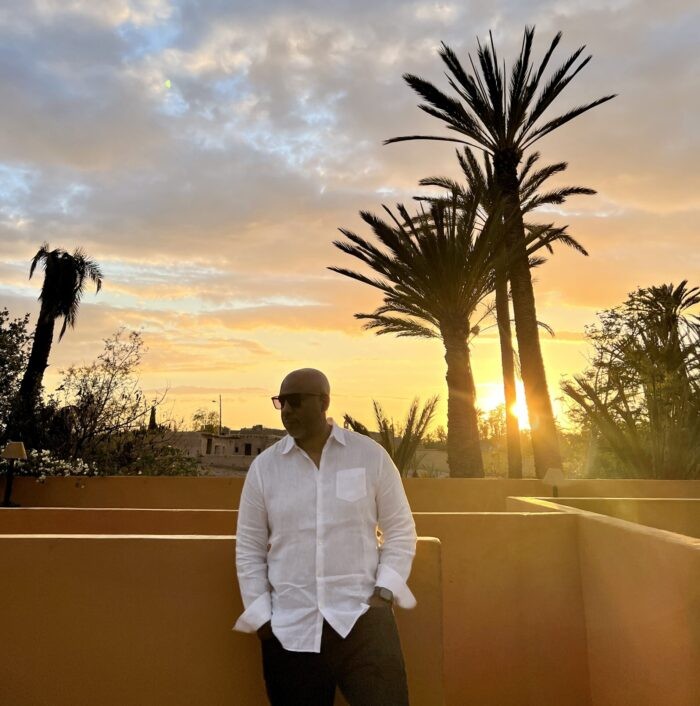 Sunset view from Jnane Tamsna, Marrakech, showcasing the beautiful Moroccan sunset and rooftop ambiance
Sunset view from Jnane Tamsna, Marrakech, showcasing the beautiful Moroccan sunset and rooftop ambiance
10.6. Example Itinerary
- Casablanca: 1 night
- Fes: 2 nights
- Sahara/Merzouga: 1 night (glamping)
- Dades/Atlas Mountains: 1 night
- Marrakech: 3 nights
This itinerary involves a lot of driving. If you have less time, focus on one or two cities, such as Marrakech.
11. What Traditional Foods & Beverages Should I Try In Morocco?
Moroccan cuisine is aromatic and full of spices. Be sure to try these traditional foods and beverages:
- Couscous: Morocco’s national dish, traditionally served with a stew of meat and/or vegetables.
- Harira: A soup made from tomatoes, lentils, chickpeas, and lamb, typically served during Ramadan.
- R’fissa: A Casablanca staple made with flaky pancakes, chicken in onion broth, and herbs and spices.
- Tanjia: A Marrakech dish of lamb or veal prepared in a terracotta jar.
- Tagine: A dish cooked in a clay pot, usually with slow-cooked chunks of lamb, beef, or chicken with herbs and spices.
- Pastilla (Bastilla): A savory meat pie with a poultry or seafood filling, featuring a sweet and complex flavor.
- Zalouk: A popular spread made of eggplants, garlic, tomatoes, olive oil, and spices, served with bread.
- Gazelle Horns: Moroccan cookies with an almond and orange blossom filling.
- Chebakia: A honey-dipped fried sesame cookie in the shape of a flower.
- Msemen: Flatbread eaten for breakfast and as a street food, either sweet or savory.
- Baghrir: Moroccan pancakes known as “thousand hole pancakes.”
- Mint Tea: The most popular beverage in Morocco, made with fresh mint and sugar.
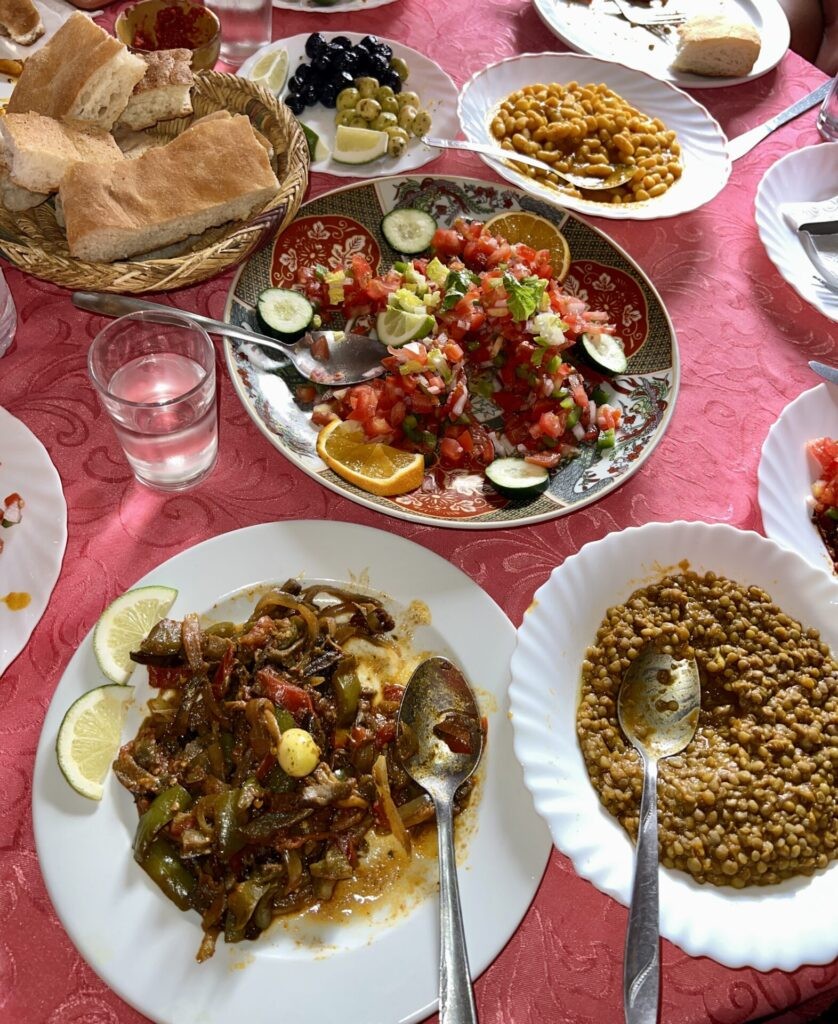 A meal in a Casbah in Dades, featuring an assortment of beans, vegetables, tomatoes, and bread, typical Moroccan appetizers
A meal in a Casbah in Dades, featuring an assortment of beans, vegetables, tomatoes, and bread, typical Moroccan appetizers
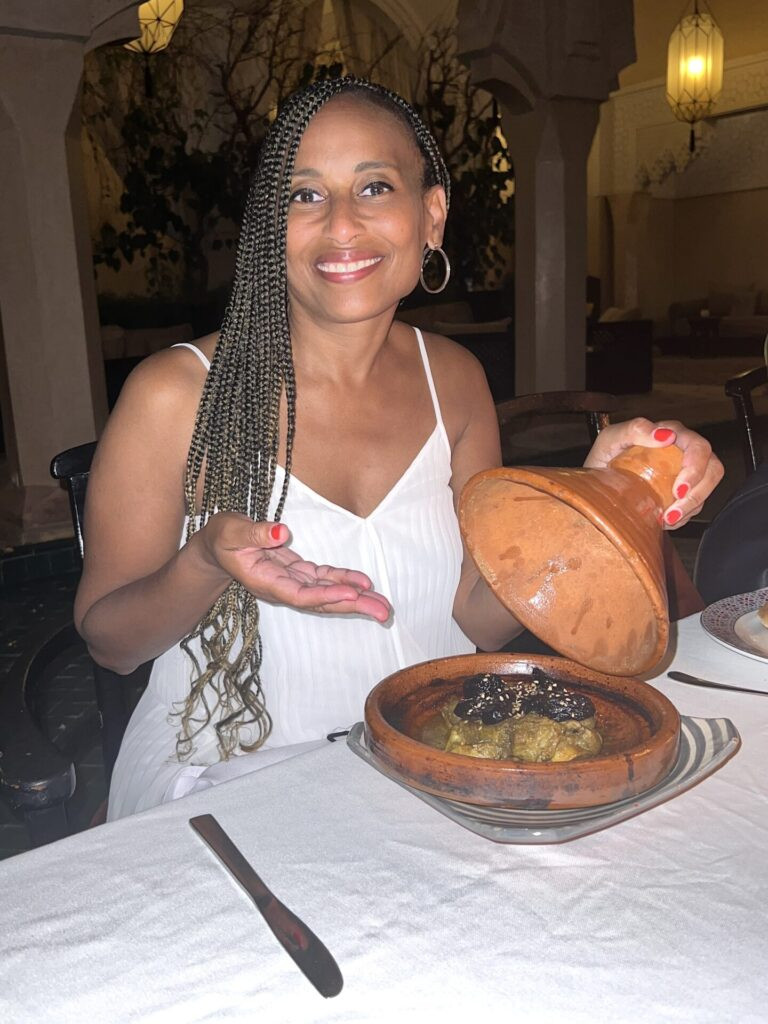 Nadeen enjoying a Tagine meal of beef with prunes, showcasing a classic Moroccan dish
Nadeen enjoying a Tagine meal of beef with prunes, showcasing a classic Moroccan dish
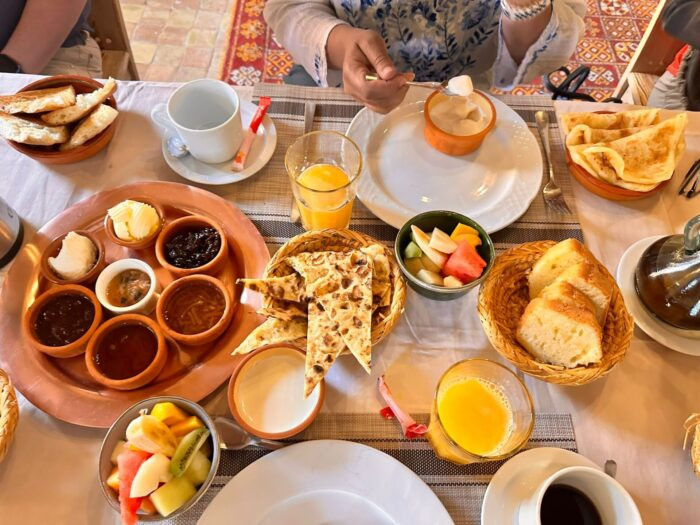 A typical Moroccan breakfast spread, featuring an array of pancakes, pastries, and local delicacies
A typical Moroccan breakfast spread, featuring an array of pancakes, pastries, and local delicacies
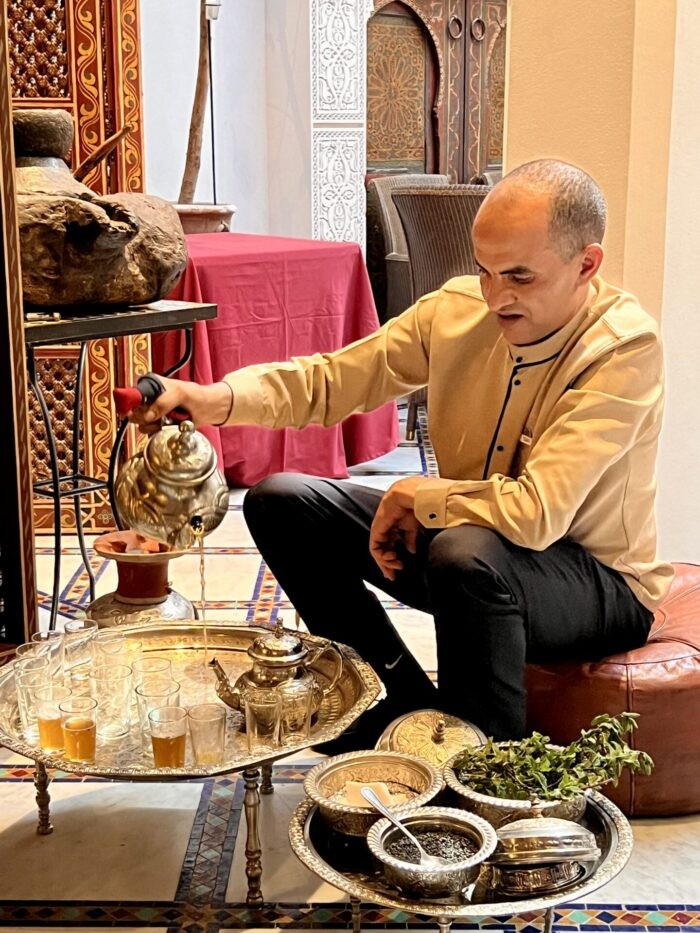 Mint tea being prepared during a cooking class, highlighting the traditional Moroccan beverage
Mint tea being prepared during a cooking class, highlighting the traditional Moroccan beverage
12. What Are The Best Shopping Opportunities In Morocco?
Morocco offers amazing shopping opportunities. Budget for items like wine, leather goods, home goods, pottery, furniture, mirrors, jewelry, and clothes.
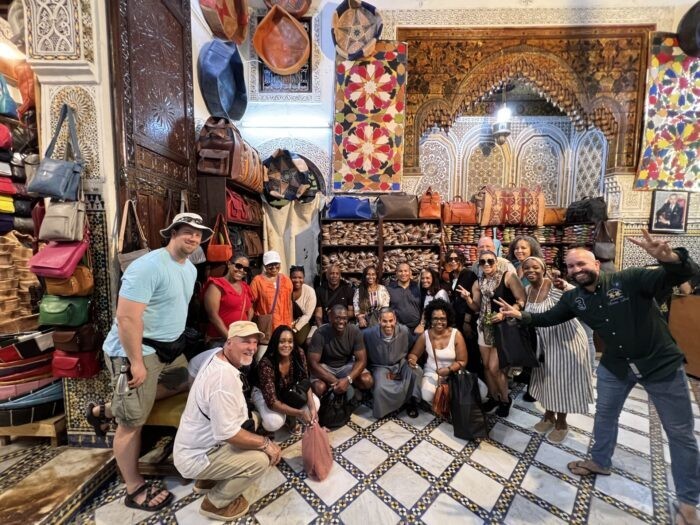 Group in a leather shop, highlighting the variety of leather goods available in Morocco
Group in a leather shop, highlighting the variety of leather goods available in Morocco
FAQ Section: How To Travel In Morocco
1. Is Morocco safe for tourists?
Yes, Morocco is generally safe for tourists. However, like any travel destination, it’s important to stay aware of your surroundings, especially in crowded areas and tourist spots. Petty theft can occur, so keep your belongings secure.
2. What is the best way to exchange currency in Morocco?
The best way to exchange currency is at ATMs, which typically offer decent exchange rates. You can also exchange money at the airport, but it’s advisable to compare rates. Ensure you have cash, as many smaller establishments prefer it.
3. Can I use credit cards in Morocco?
Credit cards are accepted in most restaurants and main shops, but smaller shops in the souks usually prefer cash. American Express is not as widely accepted as Visa or Mastercard.
4. What should I pack for a trip to Morocco?
Pack modest clothing that covers your shoulders, chest, and knees. Lightweight pants, long dresses, and skirts are ideal. Also, bring a scarf for visiting mosques and cooler evenings.
5. Do I need to know Arabic or French to travel in Morocco?
While Arabic and French are widely spoken, English is common in the tourism industry. Learning a few basic phrases in Arabic or French can enhance your experience.
6. What is a Riad, and why should I stay in one?
A Riad is a traditional Moroccan house or palace with an interior garden or courtyard. Staying in a Riad offers a unique cultural experience, often located in the heart of the Medina, providing easy access to dining and shopping.
7. How can I get around in Moroccan cities?
You can use petit taxis for short distances within cities and grand taxis for traveling between cities. Ride-sharing apps like Careem, Heetch, and Roby are also available in some major cities.
8. What is the best way to avoid scams in Morocco?
To avoid scams, be cautious of unsolicited offers of help, negotiate prices before accepting services, and keep your belongings secure. Use reputable tour operators and transportation services.
9. Are there any cultural customs I should be aware of in Morocco?
Yes, dress modestly, especially when visiting religious sites. Avoid public displays of affection and be respectful during Ramadan. Always use your right hand when eating or handling objects.
10. What are some must-try dishes in Morocco?
Must-try dishes include Tagine, Couscous, Pastilla, Harira, and Mint Tea. These dishes offer a rich taste of Moroccan cuisine and culture.
Planning a trip to Morocco doesn’t have to be daunting. With this guide and the support of SIXT.VN, you can ensure a smooth, enjoyable, and unforgettable experience. From visa requirements to transportation, accommodations, and cultural insights, you’re now equipped to explore the best of Morocco.
Explore Morocco with SIXT.VN
Ready to start your Moroccan adventure? SIXT.VN offers a range of services designed to make your trip seamless and stress-free. From airport transfers and hotel bookings to guided tours and car rentals, we’ve got you covered.
- Airport Transfers: Start your trip right with reliable and comfortable airport transfer services.
- Hotel Bookings: Choose from a wide selection of Riads and hotels to suit your style and budget.
- Guided Tours: Discover the best of Morocco with our expertly guided tours.
- Car Rentals: Enjoy the freedom to explore at your own pace with our car rental services.
Don’t let the challenges of planning a trip hold you back. Let SIXT.VN handle the details, so you can focus on creating unforgettable memories in Morocco.
Address: 260 Cau Giay, Hanoi, Vietnam
Hotline/Whatsapp: +84 986 244 358
Website: SIXT.VN
Book your Moroccan adventure with SIXT.VN today and experience the magic of this captivating country with ease and confidence.



